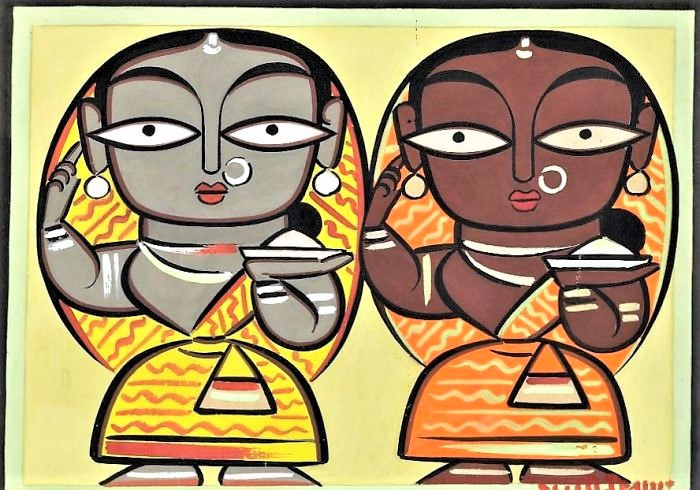Jamini Roy Art is a painting style developed by the famous Indian artist Jamini Roy. Jamini Roy was an Indian painter (11th April 1887-24th April 1972) whose contribution to Indian art is unfathomable. He was a student of Government College of Art, Kolkata under the guidance of famous painter Abanindranath Tagore. Although he was taught the traditional Western art methods, soon he looked for new inspiration in Indian traditional folk art and created his own originality. He became best known for blending traditional Indian art and Western art for creating unique and complex works.
Painting Style and its Development
After graduating from the Government College of Art, Jamini Roy used to get regular commissions for portraits drawn by using traditional Western techniques during 1916. But with the surge in nationalism and freedom movement at that time, he consciously rejected the Western-style and delved into Indian traditional and folk artforms to get his inspiration for painting and develop his own originality. His style includes impressions of East Asian calligraphy, terracotta temple friezes, Ajanta cave paintings, and Kalighat paintings or the Kalighat Patachitra. This style showcases bold sweeping brush strokes. He also switched to vegetable and mineral sources for colours instead of oil colours. His various styles are :
- The Santhal Paintings: These paintings reflect the scenes from villages, capturing the essence of rural life. They were painted during the early 1920s with firm, angular lines which Jamini Roy referred to as the flat technique. Jamini Roy had painted a series of Santhal paintings depicting Santhal women doing daily chores, peasants, artisans, and followers of religious cults with great dignity. The Three Pujarini, Drummer, Blacksmith, Santhal Dance are the famous paintings of Jamini Roy.
- The Calligraphic Brush Drawing: Jamini Roy switched to this style during the mid-1920s when he started using sweeping, calligraphic lines which reflected his controlled brushwork. These drawings are mostly monochromatic with shades of white, soft grey, yellow ochre, and black which point at the inspiration of the Kalighat Patachitra. Bal Gopal, Woman Seated, Man Smoking are examples of this style.
Elements of Jamini Roy Art
Jamini Roy's art comprises several elements, both natural and man-made. Also, besides his folk-themed works, his portraits and European-styled paintings are examples of the masterclass. The elements of Jamini Roy arts are :
- Birds and Beasts: The elegant lighter touches of Jamini Roy were most profoundly reflected in the paintings of birds and beasts. Examples are Cat and the Lobster and the Bull.
- Epics, Mythologies, and Folk Cults: Jamini Roy introduced a narrative element as he laid his hand in the painting of figures and stories from Ramayana and Mahabharata. An example of such a painting is his Krishna Leela series. This series is unique as instead of Roy’s signature erect figures in other paintings, here the figures lie on a bent or dynamic axis.
- The Life of Christ: This series is considered the most powerful series of paintings by Jamini Roy. It centered around the life of Jesus Christ but in his own style with a familiar appearance as if he is the man who lives next door. He painted Christ in Hieratic poses, with vibrancy and grave, contemplative faces. Example: Crucifixion, Flight to Egypt, Christ with Cross, Christ and a Boy, and Christ Preaching.
- The Mother and Child: This is another remarkable series of Roy’s work that reflects infinite variations of mother and child figures mostly showing a child in the lap of a mother and the mother wearing a traditional Bengali saree. Scholars feel that this was either an influence of the freedom movement going on during that time period where the country was often referred to as the Mother or might be a depiction of Mother worship which is still relevant in Bengali society. Examples of mother and child series are Mother and Child, Materna, Mother and Child(white border), Bengali Woman, etc.
- Portraits, Landscapes and Copies of European Masters: Although Jamini Roy had switched to Indian traditional and folk art in the 1920s, he still continued painting European style portraits with Impressionist and Pointillist brush strokes. Later, he had changed his medium to tempera which he had also used to paint local landscapes. He had also copied the works of some great European masters. Examples of such works are Black Horse, Three Boats, Portrait of a Lady, etc.
Recognition of the Art and Artist
The Jamini Roy Artworks are displayed in various museums around the world like Victoria and Albert Museum in London, National Art Gallery in India which are highly revered by art lovers. Jamini Roy was also the first Indian painter who was honoured with Fellow of the Lalit Kala Akademi in 1955 which is the highest honour and recognition that can be bestowed by the Government of India in the field of arts. In 1976, his works were included in the ‘Nine Masters’, by the Archaeological Survey of India. He was awarded the Padma Bhushan Award in 1954. Google also came up with a special Google Doodle on 11th April 2017 to celebrate his 130th birth anniversary.
Current Scenario
Jamini Roy Art is very popular among Bengalis and art lovers around the world. Various paintings, wall hangings, and Pats are found in Bengali households. Students are also taught this style at art colleges. The paintings are also exhibited and sold from various exhibitions and online platforms. ArtsofIndia is such a platform that also sells and promotes Jamini Roy arts and paintings; sarees, wall hanging and home decors, a variety of attires, fashion accessories, and face masks illustrating Jamini Roy artform. His artworks are a showcase of a perfect blending of Bengali folk art and culture which has still mesmerized art lovers of far and near.
Picture Source: ArtsofIndia



